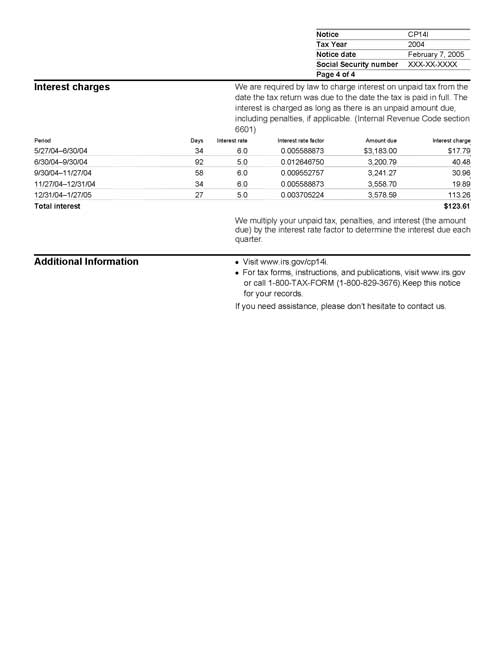Understanding your CP14I Notice
You owe taxes and penalties because you didn't take out the minimum amount you had to from your traditional individual retirement arrangement (IRA). Or, you put into a tax-sheltered account more than you can legally.
What you need to do
- Read your notice carefully — it'll explain how much you owe and how to pay it.
- Pay the amount you owe by the date the notice asks.
- Make a payment plan if you can't pay the full amount you owe.
- Contact us if you disagree.
You may want to...
- Download copies of the following materials (if they were not included with your notice):
- Publication 1, Your Rights as a Taxpayer
- Publication 590, Individual Retirement Arrangements (IRAs)
- Publication 969, Health Savings Accounts and Other Tax-Favored Health Plans
- Publication 970, Tax Benefits for Education
- Publication 594, The IRS Collection Process
- Notice 746, Information About Your Notice, Penalty and Interest
- Form 9465, Installment Agreement Request
- Call 1-800-TAX-FORM (1-800-829-3676) to order forms and publications.
- Learn more about Individual Retirement Arrangements.
- Learn more about how to make a payment plan.
- Learn more about how to submit an Offer in Compromise.
- Fill out and send us a Form 2848, Power of Attorney and Declaration of Representative to allow someone (such as an accountant) to contact us on your behalf.
Answers to Common Questions
What is a traditional individual retirement arrangement (IRA)?
A traditional IRA is a retirement savings plan where the amount you put in is tax-deductable. The money you put in is usually not taxed until you take it out. A traditional IRA is not a Roth IRA or a SIMPLE IRA.
What is a Roth IRA?
A Roth IRA is a retirement plan where the amount you put in is taxable. But what the amount earns and what you take out is not taxable.
What is a SIMPLE IRA?
A SIMPLE IRA is a retirement plan sponsored by your employer. You put part of your pay into it. Your employer matches a certain amount of what you put in. You don't pay tax on what you and your employer put in until you take it out.
How much do I have to take out from my traditional IRA?
You must take out a minimum amount from your IRA starting at age 70½. The amount you have to take out is based on your life expectancy. Publication 590, Individual Retirement Arrangements (IRAs) has a life expectancy chart. You divide the money in your account by the years of your life expectancy. The result is the minimum amount you must take out. You don't have to take out a minimum amount from Roth IRAs.
Are there different types of tax-sheltered accounts?
The different types of tax-sheltered accounts, besides retirement accounts, could include saving accounts for educational or medical expenses.
What is the maximum amount I can contribute to a tax-sheltered account?
The maximum amount depends on the type of account.
What happens if I can't pay what I owe?
You can make a payment plan if you can’t pay the full amount you owe.
How can I make a payment plan?
Call us at the toll free number on the top right corner of your notice to talk about payment plans or learn more about them.
What should I do if I disagree with the notice?
Call us at the toll free number on the top right corner of your notice. Please have your paperwork (such as cancelled checks, amended return, etc.) ready when you call.
Am I charged interest on the money I owe?
Not if you pay the full amount you owe by the date on the payment coupon. However, interest adds up on the unpaid amount after that date.
Will I receive a penalty if I can't pay the full amount?
Yes, you'll receive a late payment penalty. Call us at the number on your notice if you can't pay the full amount because of financial problems. We may be able to remove the penalty.
Tips for next year
Consider filing your taxes electronically. Filing online can help you avoid mistakes and find credits and deductions that you may qualify for. In many cases you can file for free. Learn more about e-file.
Understanding your notice
Reading your notice
Your notice may look different from the sample because the information contained in your notice is tailored to your situation.
Notice CP14I, Page 1

Notice CP14I, Page 2

Notice CP14I, Page 3

Notice CP14I, Page 4

Printable samples of this notice (PDF)
Tax publications you may find useful
- Publication 590, Individual Retirement Arrangements (IRAs)
- Publication 969, Health Savings Accounts and Other Tax-Favored Health Plans
- Publication 970, Tax Benefits for Education
- Publication 594, The IRS Collection Process
- Notice 746, Information About Your Notice, Penalty and Interest
- Form 9465, Installment Agreement Request
- Form 656 Booklet, Offer in Compromise
- Find a copy of any necessary tax forms and instructions
How to get help
Calling the 1-800 number listed on the top right corner of your notice is the fastest way to get your questions answered.
You can also authorize someone (such as an accountant) to contact the IRS on your behalf using this Power of Attorney and Declaration of Representative (Form 2848).
Or you may qualify for help from a Low Income Taxpayer Clinic.
